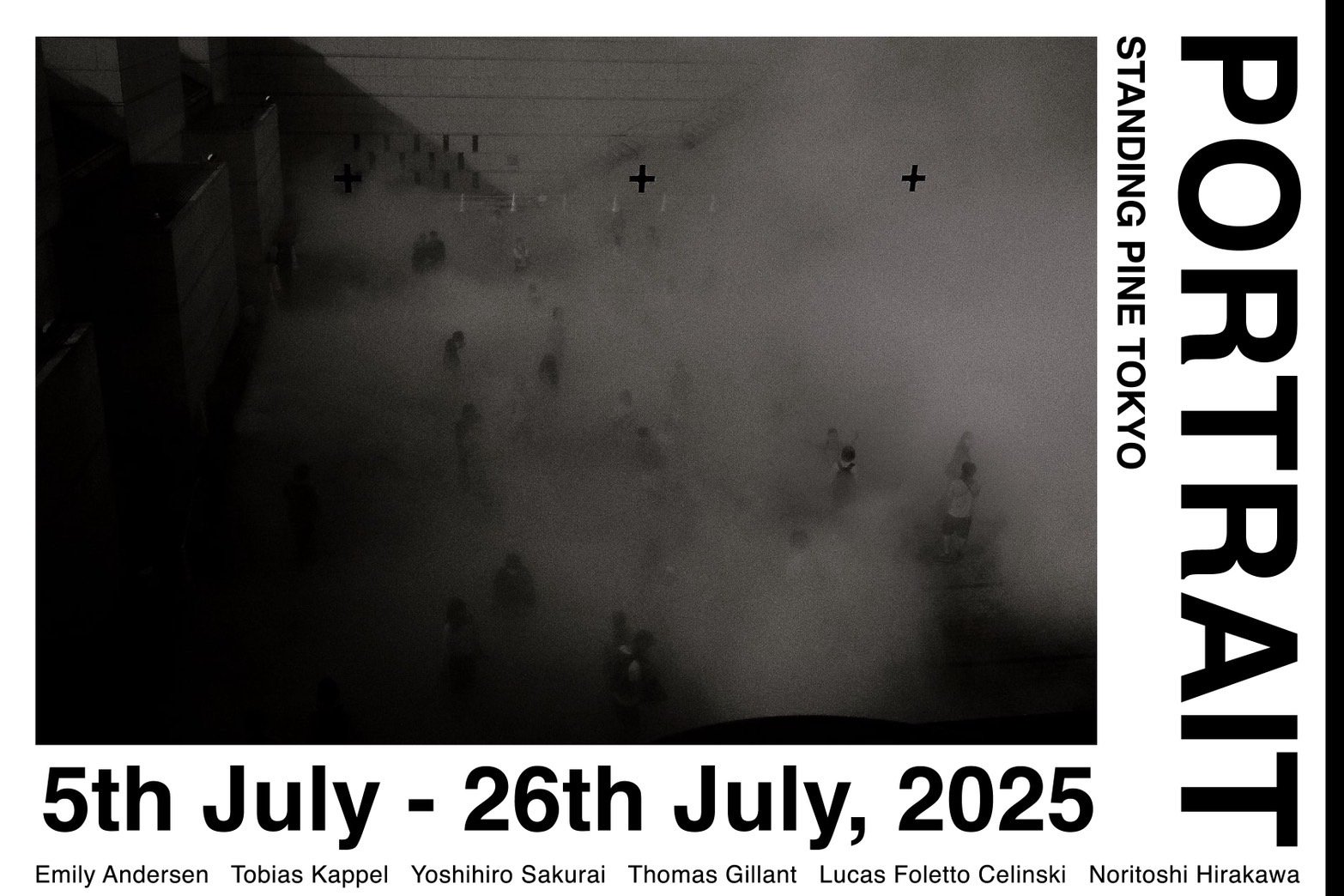
PORTRAIT
cooperation in organizing the group exhibition of STANDING PINE TOKYO
Emily Andersen
Tobias Kappel
Yoshihiro Sakurai
Thomas Gillant
Lucas Foletto Celinski
Noritoshi Hirakawa
5th July - 26th July, 2025
OPEN 12:00 - 18:00 / CLOSED: Sunday, Monday, Public Holiday
OPENING RECEPTION: 5th July (Sat) 17:00 - 19:00 at Standing Pine Tokyo
Yoshiro Sakurai I The Presence of Absence / Gelatin Silver Print / 570 × 900 / 2025
この度、LOWWは企画協力として、7月5日(土)よりSTANDING PINE 東京で行われる、グループ展「PORTRAIT」を開催いたします。本展には、エミリー・アンダーセン(イギリス)、トビアス・カッペル(ドイツ)、櫻井啓裕(日本)、トマ・ジラン(フランス)、ルーカス・フォレット・セリンスキ(ブラジル)、平川典俊(日本)の6名が参加いたします。
「ポートレイト」という言葉が喚起する伝統的な肖像表現から逸脱しながらも、その本質にあらためて向き合おうとする本展では、参加作家たちによる作品が、イメージや記録、身体性、セクシュアリティ、時間といった多層的な要素を内包し、それぞれが人と作品との関係性に新たな視点を投げかけます。
エミリー・アンダーセンは、廃墟となった産業施設や都市のインテリア空間を静謐な視点で撮影し、日常の中に潜む詩情や記憶の痕跡を映し出す作品を制作しています。また、1980年代よりポートレート写真を撮り続けており、今回展示されるナン・ゴールディンをはじめ、数多くの著名な作家、詩人、映画監督、俳優、建築家たちを被写体としています。彼女の映し出す世界には、雰囲気や詩的な表現への美意識が一貫して息づいており、さらに、彼女は写真というメディアを通じて、肖像という言語、時間という概念、そして記憶の表象を探求し、日常を静止画として捉えるそのプロセスを丹念に研究し続けています。
写真が現実を写すだけのメディアではなくなった現代において、トビアス・カッペルは、イメージ制作の新たな可能性を探求しています。アナログとデジタルの中間領域を横断する彼の作品は、ジャンルの境界を超えながら、視覚表現の真正性や最終性に問いを投げかけます。「impssbl's nthng(2019)」は、オールインワン・プリンターの機能を用いて制作されたシリーズ「brother」の一作であり、スキャンや複製の過程で生じるノイズやエラーを積極的に取り込みながら、機械が視覚情報をどのように「見て」「理解するか」を遊び心と批評性をもって探ります。
櫻井啓裕による「Untitled (#5)(2025)」と「Untitled (#7)(2025)」は、2002年にパリのファッションショーで撮影されたバックステージの情景をもとに構成された作品です。オートクチュールの舞台裏に漂う緊張感や高揚感、モデルたちの繊細な表情を記録を超えた視点でとらえたこれらの写真は、23年の歳月を経て、記憶と時間が交差する静謐なナラティブとして立ち上がります。また、最新作では、「匿名性」と「集団性」そして「不在の気配」を通して人間の存在の輪郭を描き出し、アーティストの不在を感じながらも、その余韻に身を浸す彼らの姿は、記憶や感情の中に刻まれた「肖像」として浮かび上がります。そして、霧の中に浮かび上がる群衆は、それぞれが孤立しながらも、全体としては「一つの感情の塊」のように見え、個人は輪郭を失い、集合的な「気配」や「感受性」だけが立ち現れます。
空間全体との関係性に呼応し、そのネガティブスペースを浮かび上がらせるように設置されるトマ・ジランの立体作品は、彼のドローイング作品に通底する、平面と奥行きの錯覚のあいだで生まれる視覚的相互作用と対をなしています。空間そのものを一つの自律したアイデンティティとして捉えるとき、そこに設置されたこの作品が立ち上げる空間的な存在感は、まるで空間そのもののポートレイトを描き出しているかのようです。
ルーカス・フォレット・セリンスキの作品は、身体を束縛と解放の場として見つめ、クィア・セクシュアリティに焦点を当て、快楽のニュアンスと身体体験による強烈な感覚について考察します。そして、ジュエリー制作やテキスタイル、アナログ写真、手焼きプリントといった手作業を重視した技法を用いることで、身体をめぐる感覚的な体験を物質性をもって表現しています。より親密な世界を描き出したモンタージュ写真シリーズ「La Petite Mort」では、快楽、愛、死といった根源的なテーマに詩的にアプローチし、感覚の極限に触れるような瞬間を繊細に捉え、アナログモンタージュ写真、多重露光、シルクスクリーン、写真をほかのメディウムに移行するフォトトランスファーといった技法を駆使しながら、BDSMの恋人や友人たちを映し出した視覚的なイメージと、裸身であり、官能的である一般的な芸術彫刻を重ね合わせることで、プライベートで親密な刹那と典型的な身体表現との対話を生み出しています。
平川典俊は、ユング心理学における「アニマ」の概念を出発点に、女性が自身の内に抱える男性像=アニマを被写体として演じることに着目した写真シリーズ「The anima’s talent」を制作しています。アニマを単なる女性像の元型ではなく、内面に潜む男性性として捉え、女性がその役割を引き受けることで、逆説的に「内面に存在しない女性性=他者としての男性性」を演じるプロセスが浮かび上がります。本シリーズでは、歌舞伎や宝塚といったジェンダーの演技的伝統にも言及しながら、快楽やアイデンティティの構造にアプローチします。今回の出品作では、南明奈がその「アニマ」の被写体を演じ、写真の中で女性性と男性性の揺らぎを可視化するものです。
本展覧会を通して、彼らの作品と対峙するなかで浮かび上がる「差異」は、鑑賞者の個人的な記憶や経験と結びつきながら、肖像という表現形式のあり方を静かに問い直します。
More articles via STANDING PINE website (Japanese)
LOWW is pleased to announce its cooperation in organizing the group exhibition “PORTRAIT,” which will be held at STANDING PINE Tokyo from July 5, 2012. A group exhibition opening on Saturday, July 5. The exhibition brings together six artists: Emily Andersen (UK), Tobias Kappel (Germany), Yoshihiro Sakurai (Japan), Thomas Gillant (France), Lucas Foletto Celinski (Brazil), and Noritoshi Hirakawa (Japan).
While diverging from the traditional notions of portraiture evoked by the term itself, this exhibition seeks to reengage with its essential concerns. The participating artists’ works encompass layered themes: image, documentation, embodiment, sexuality, and time, each offering new perspectives on the relationship between subject and artwork.
Emily Andersen creates photographic works that quietly capture the remains of abandoned industrial facilities and the interiors of urban architecture, revealing poetic stillness and traces of memory embedded within the everyday. Since the 1980s, she has also continued to pursue portrait photography, depicting a wide range of celebrated figures, including Nan Goldin, featured in this exhibition, as well as notable writers, poets, filmmakers, actors, and architects. Her work consistently reflects a refined aesthetic sensitivity to atmosphere and poetic expression. Moreover, through the medium of photography, she has engaged in a sustained inquiry into the language of portraiture, the concept of time, and the representation of memory, while diligently examining the process by which the everyday is transformed into a still image.
In an era when photography is no longer confined to mirroring reality, Tobias Kappel explores new possibilities in image-making. His works navigate the in-between space of analogue and digital processes, transcending genre boundaries while questioning the authenticity and finality of visual expression. “impssbl’s nthng (2019)”, part of his ‘brother’ series, was created using the functions of an all-in-one printer. Embracing the noise and errors that emerge during processes of scanning and duplication, the work critically and playfully investigates how machines ‘see’ and ‘interpret’ visual information.
Yoshihiro Sakurai’s “Untitled (#5)” and “Untitled (#7)” (both 2025) are based on backstage scenes he photographed during a Paris fashion show in 2002. Capturing the tension and exhilaration that pervade the world of haute couture, along with the subtle expressions of the models, these photographs offer a perspective that surpasses mere documentation. Now, after 23 years, they emerge as a quiet narrative where memory and time intersect. In his latest works, Sakurai delineates the contours of human existence through the themes of “anonymity,” “collectivity,” and a “sense of absence.” While the artist remains unseen, the figures who immerse themselves in its lingering presence quietly emerge as portraits engraved in memory and emotion. The crowd that appears through the mist, though composed of isolated individuals, collectively forms a singular emotional mass. In this space, the boundaries of the individual dissolve, and only a shared ‘presence’ or ‘sensitivity’ quietly emerges.
Installed in dialogue with the exhibition space, Thomas Gillant’s sculptural works draw attention to their negative spaces. These installations resonate with the visual interplay found in his drawing practice, an exploration of perceptual tension between surface and depth, where illusions of spatiality emerge and dissolve. By approaching space as an autonomous identity in itself, Gillant’s installations generate a spatial presence that seems to render a portrait not of a person, but of space itself.
Lucas Foletto Celinski’s work explores the body as a site of both constraint and liberation, focusing on queer sexuality and the nuances of pleasure, as well as the intense physical sensations of embodied experience. His practice employs tactile, craft-based methods such as jewellery making, textile work, analogue photography, and hand printing, using material processes to evoke sensorial engagement with the body. His photo-montage series ‘La Petite Mort’ presents a more intimate scale, offering a poetic reflection on fundamental themes such as pleasure, love, and death. The series delicately captures fleeting, transcendent moments at the edge of sensation, using techniques including analogue photomontage, multiple exposure, silkscreen, and photo transfer to other media. These works juxtapose images of lovers and friends engaged in BDSM with classical sculptural representations of the nude, erotic body, establishing a dialogue between private, intimate encounters and public portrayals of sensuality.
Noritoshi Hirakawa’s photographic series ‘The anima’s talent’ begins with the Jungian psychological concept of the “anima.” Rather than interpreting the anima as a mere archetype of femininity within the male psyche, Hirakawa redefines it as a latent form of masculinity residing within the female subject. In this series, women perform this internal male image—the anima—as a role, revealing a paradoxical process in which they embody not femininity itself, but the “femininity-as-other” through the lens of internalised masculinity. Drawing on gendered performance traditions such as Kabuki and the Takarazuka Revue, Hirakawa approaches the structures of pleasure and identity that arise from this layered performance. The act of enacting the anima becomes a form of visual oscillation between femininity and masculinity, questioning fixed notions of gender and representation. In this presentation, Japanese model Akina Minami performs the role of the anima, rendering visible the fluid interplay between masculine and feminine in photographic form.
Throughout the exhibition, the ‘differences’ that emerge in dialogue with these works become entangled with the viewer’s personal memories and experiences, quietly prompting a reconsideration of what portraiture, as a form of expression, can be.
More articles via STANDING PINE website (English)

